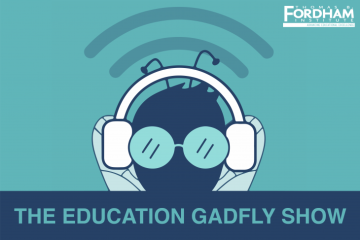This week, John Catt USA published Follow the Science to School: Evidence-based Practices for Elementary Education, a new book edited by Barbara Davidson, Kathleen Carroll, and Fordham Institute president Michael J. Petrilli. The following editorial is adapted from its introduction.
“Follow the Science”
Those three words became a rallying cry during the Covid pandemic. And at first blush, the message seems straightforward: Identify best practices according to the evidence, and then do them.
But it’s not quite that simple in the real world, whether the subject is how to respond to a deadly virus, how to educate our children, or how to do both at the same time.
The first challenge is defining “the science.” As Jonathan Rauch of the Brookings Institution explains in his recent book, The Constitution of Knowledge, science is no stationary thing. It is constantly changing, as researchers publish fresh studies, new bits of knowledge are added to the old, and old understandings are overtaken by new ones. We certainly saw this with the pandemic, as we learned over time how the novel coronavirus was transmitted (by air, not on surfaces), and thus how best to mitigate its spread (by avoiding poorly ventilated and crowded spaces, not by deep cleaning).
It’s also clear that “the science” is constantly contested, both by scientists and the larger public. That’s actually the essence of science: No one gets the exclusive right to claim what the evidence says, much less a permanent right to do so. As Rauch argues, the scientific endeavor is, by its very nature, a social exercise. It’s a process; a conversation. A community of informed individuals argues and debates until something approaching a consensus emerges, and then they start again. That’s why we need to “follow” the science—it keeps moving, it’s never static.
“Following the science” is seldom easy, especially in the realm of education. What science did we follow when we shifted American schools to remote learning in March 2020 and, for many schools, continued that well into the 2020–21 school year? While keeping kids at home reduced the spread of Covid, this decision also had an enormous negative impact on many students’ academic achievement and mental health. As experiences mount and evidence grows, our understanding grows more complex. Following the science involves tradeoffs, value judgments, and the complications, compromises, and tough choices that are endemic in the real world.
Yet for all its limitations and complexities, “following the science” is one of the primary ways that we humans have made progress over the centuries. It has allowed us to solve problems at a global scale and brought us lifesaving vaccines to counter Covid in less than a year. It is why drinking water in the developed world is almost always clean, why farms can feed billions, why infant mortality has plummeted, why life spans have expanded in ways that our ancestors could have never imagined, and it is why we live with advanced technologies and living standards for ordinary folk that surpass those of kings and queens of yesteryear.
“Following the science” is also one of the primary ways that we can improve our schools so that all American children finally gain the opportunity to fulfill their potential and thrive in the world they will inherit. The urgency of this goal only grew during the pandemic, which cruelly disrupted the home and school lives of children around the world.
Our hope with our new book is to identify what the science tells us about evidence-based practices in elementary schools, and to describe what they look like in the real world of classrooms. Following the science into its application in this way—and sharing how it works on the ground—enables us to suggest workable answers to key questions, rather than challenging every teacher, school, or district to figure out those answers on their own.
We’re talking here about the fundamental questions of elementary education, such as:
- How can young children make sense of the code that is the alphabet? How can we help them move smoothly from sounding out words to reading fluently and confidently?
- How does “reading comprehension” develop? Is it a skill to be learned? Or is it more like a process—driven by how much students know about the world via subjects like history and geography and science?
- How can elementary students be taught to write effectively? Should we worry about spelling, grammar, and punctuation right away, or can that come later? How can we teach children to write strong sentences, paragraphs, and essays?
- What about math? Should we simply teach kids that 9 + 6 = 15—memorize it now!—or is there a phase when it’s better to show them various strategies to figure out and understand why 9 and 6 add up to 15? Are there some ways to teach fractions that work better than others?
- Should students practice reading skills with books at their current reading level or at one that corresponds to their assigned school grade (and above)?
- How should teachers manage their classrooms? What’s the best way to keep an orderly, yet friendly, environment?
Let’s get one thing clear right away: Not everything that makes an elementary school great can be pinned to “evidence.” Skillful teaching and inspired leadership are each an art and a science. And science can’t always give us a single strong answer to every question.
But it often does. The science is out there. The evidence can point the way. And there are good approaches to meeting the challenges that thousands of teachers and students encounter every day. When the adults in charge ask for evidence and put it into practice, we can do better by our students tomorrow than we did yesterday.
What counts as “evidence”?
Yes, it’s a genuine challenge. If we set our evidentiary standards impossibly high and look only to gold-standard experimental studies, we risk limiting ourselves to questions that lend themselves to randomization or to practices, tools, and materials that have been on the market long enough (and have enough financial backing) to allow for robust, expensive evaluations. But if we set our standards too low, we risk encouraging practices that may look “promising” but might be ineffective—or even harmful.
Our approach is to turn to the core tenets of science that have served us well, in all fields, for hundreds of years. In Rauch’s words, those “rules for reality” are:
- The fallibilist rule: No one gets the final say. You may claim that a statement is established as knowledge only if it can be debunked, in principle, and only insofar as it withstands attempts to debunk it.
- The empirical rule: No one has personal authority. You may claim that a statement has been established as knowledge only insofar as the method used to check it gives the same result regardless of the identity of the checker, and regardless of the source of the statement.
These rules mean that people can’t just make stuff up or claim that certain practices are “evidence-based” just because someone said they are. But they also leave room for many different approaches to identify plausible practices and test them against the rigors of the real world. And they certainly mean going beyond randomized experiments.
For example, in the book, we point to rigorous analyses that examine whether particular instructional materials are faithful to evidence-based practices that themselves have been validated by experimental studies. This approach is several steps removed from subjecting the instructional materials themselves to controlled experiments, but we think that’s OK.
Likewise, we laud rigorous attempts to chronicle what high-performing schools and highly effective teachers do in their classrooms, most famously the work of Doug Lemov and his colleagues on the Teach Like a Champion team.
We believe this approach is in line with the one embraced by Congress in the Every Student Succeeds Act of 2015. That law mentions the term “evidence-based practice” over one hundred times, and defines the term via four tiers: strong, moderate, promising, and “under evaluation.”
Curriculum is key
A constant drumbeat in the book is the importance of high-quality instructional materials. We do not believe it makes sense for each one of America’s teachers or principals, or even chief academic officers at the district or charter network level, to try to interpret the research evidence on their own. Such an approach would be isolating, time-consuming, costly, and inefficient.
Instead, we believe that instructional materials are the ideal vehicle for turning evidence into practice. Curriculum developers—with insights from academics and practitioners—should develop evidence-based resources designed for the reality of the classroom, so educators can put them to their best purpose. We don’t have to be computer engineers to use computers effectively in our daily work. Likewise, teachers shouldn’t have to earn doctorates in education research to teach children effectively. If developers do their job well, then educators can focus on mastering the curriculum, rather than learning every intricacy of the underlying research studies.
Simply put, we think it is almost impossible to be an evidence-based elementary school without the adoption and implementation of high-quality instructional materials. Educators need tools that are aligned with the research, and quality instructional materials are the most critical of those tools.
—
In the wake of two horrific years, even the best elementary schools are struggling to help their students make up for lost time, relearn forgotten skills, and regain their momentum. Readers will find lots of ideas in our book about how we can help young children recover, regain, and thrive. By following the science, educators can lead our schools into a hopeful post-pandemic era.








